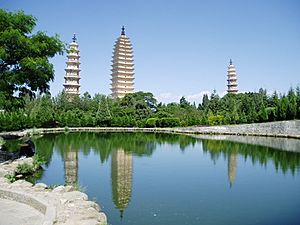Nanzhao facts for kids
Quick facts for kids
Nanzhao
|
|||||||
|---|---|---|---|---|---|---|---|
| 738–937 | |||||||

Kingdom of Nanzhao as of 879 AD
|
|||||||
| Status | Kingdom | ||||||
| Capital | Taihe (also named Yangxiemie, near present day Dali) | ||||||
| Religion | Buddhism | ||||||
| Government | Monarchy | ||||||
| History | |||||||
|
• Established
|
738 | ||||||
|
• Overthrown
|
937 | ||||||
|
|||||||
| Today part of | China Laos Myanmar |
||||||
| Nanzhao | |||||||||
|---|---|---|---|---|---|---|---|---|---|
| Chinese name | |||||||||
| Traditional Chinese | 南詔 | ||||||||
| Simplified Chinese | 南诏 | ||||||||
|
|||||||||
| Shan name | |||||||||
| Shan | လၢၼ်ႉၸဝ်ႈ (lâan tsāw) | ||||||||
The Nanzhao was an ancient kingdom in southern China and Southeast Asia. It existed during the 700s and 800s. Its main area was in what is now Yunnan, China.
Contents
The History of Nanzhao
Most people in Nanzhao were from the Bai people. They spoke a language called Nuosu, which is similar to Burmese. Their ancestors, the Cuan clan, moved to Yunnan around the year 225. By the 300s, they were in charge of the Yunnan area.
Early Years and Unification
In 593, the Cuan clan fought against the Sui dynasty. But the Sui dynasty stopped their rebellion in 602. After this, the Cuan clan split into two main groups.
One group, the White Mywa tribes, lived near a lake called Erhai. Around 704, another powerful group, the Tubo, made these kingdoms their tributaries. This meant the smaller kingdoms had to pay tribute to the Tubo.
In 737, the Tang dynasty helped bring these tribes together. This led to the creation of a new kingdom called Nanzhao. The name Nanzhao (南诏) means "Southern Zhao." In 738, the capital city was built in Taihe, which is south of modern-day Dali. This area was easy to defend because of the mountains, and it had good farmland.
Alliances and Conflicts
In 750, the Nanzhao kingdom attacked the Tang dynasty. The Tang governor of Sichuan sent a large army of 80,000 soldiers. But the Nanzhao army, led by Duan Jianwei, defeated them.
In 754, the Tang dynasty sent an even bigger army of 100,000 soldiers. However, this army also failed to defeat Nanzhao. After these victories, Nanzhao became allies with the Tubo. This alliance lasted until 794.
Nanzhao Expands and Attacks
In 801, Nanzhao and the Tang dynasty worked together. They defeated the Tibetans and their allies. After this, Nanzhao started to expand its territory.
From 820 to 832, Nanzhao moved into what is now Myanmar. They conquered several city-states there.
In 829, Nanzhao tried to attack Chengdu in Sichuan, but they were not successful. In the 830s, they expanded to the east and south, taking over new lands.
Between 846 and 863, Nanzhao attacked Annam, which is modern-day Vietnam. At that time, Annam was part of the Tang dynasty. In 869, Nanzhao tried to capture Chengdu again, but they failed.
The Decline of Nanzhao
By 873, the Yang family from Shanxi pushed the Nanzhao out of Sichuan. In 877, they were also forced out of Guizhou. The Nanzhao kingdom had to retreat back to Yunnan.
The kingdom slowly weakened. In 902, a chief minister murdered most of the royal family, including the person who was supposed to become the next king. This caused a lot of chaos. Finally, in 937, a man named Duan Siping took control. He then created a new kingdom called the Dali Kingdom.
Nanzhao and Buddhism
The people of Nanzhao followed a type of Buddhism called Vajrayana. Many people in Yunnan still practice this religion today.
They called their form of Buddhism "Azhali." Azhali was a bit different from the Buddhist schools in China, like Zen (Chan Buddhism). However, it had influences from Chinese, Tibetan, and Burmese Buddhism. Nanzhao likely had strong religious connections with the Pagan Kingdom in Myanmar, Tibet, and Bengal (the Pala Empire).
Azhali Buddhism was started around 821-824 by an Indian monk named Candragupta. More monks from India arrived in 825 and 828. They helped build a temple in Heqing. The last king of Nanzhao made Buddhism the official religion of the kingdom.
Images for kids
-
The Nanzhao Dragon on Nanzhao Folklore Island, Erhai Lake, Yunnan
-
Figure of Guanyin, 9th century, Nanzhao
-
Armour of the Yi people, made of leather, wood, and hide, Qing dynasty
See also
 In Spanish: Reino de Nanzhao para niños
In Spanish: Reino de Nanzhao para niños








